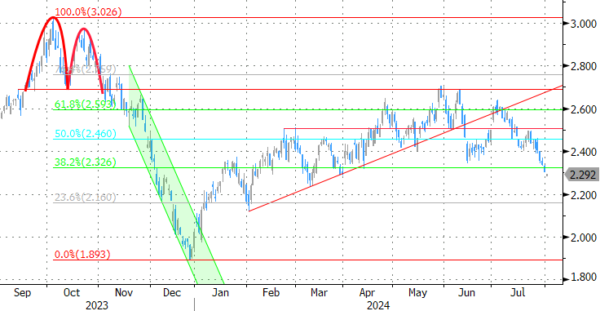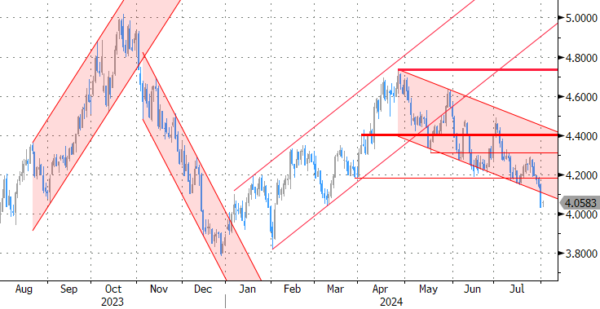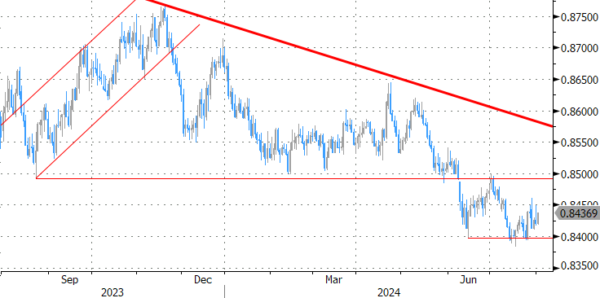Markets
The Fed kept the policy rate unchanged yesterday at 5.25-5.5%. The new statement featured some important changes compared to the June one, which are seen as paving the way towards a first, September rate cut. It noted that there was some further progress of inflation, which they now label as “somewhat” elevated, while striking a less upbeat tone on the labour market (“moderated” instead of “strong” job gains). The FOMC saw the risks of achieving its employment and inflation goals continue to move into better balance, culminating in what was the most important change: the committee turned from being “highly attentive to inflation risks” to “attentive to the risks to both sides of its dual mandate”. As such, the statement is now capturing what several Fed officials have been voicing in previous speeches, namely that the weight of the labour market in their assessment is currently as big (if not bigger) as inflation’s. Fed Chair Powell in the presser afterwards reiterated (as he did before Congress) that the labour market is no longer a source of inflation risk. The Fed did not cut yesterday because it eventually decided to first want further evidence of inflation returning to target sustainably. But Powell in the presser afterwards said they had “a real discussion” about it. So barring any accidents (eg. sharp inflation uptick), September looks like a done deal. Powell was reluctant to give any hints going forward but the lack of pushing back against current market pricing (two, close to three cuts this year and four in the next) suggests the FOMC is okay with it. The chair did note that larger-than-usual 50 bps cuts are not something they are considering right now. As such, Powell isn’t per se excluding a November cut. “Anything that we do before, during or after the election will be based on the data, the outlook and the balance of risks, and not on anything else.”, Powell said to dismiss the political sensitivity around such a decision. The FOMC’s pivot was a more explicit one than we and markets expected. US yields dropped between 9.2 and 12 bps across the curve. 4.33% support in the 2-yr broke & the 10-yr dropped out of the downward trading range to the March low. Some final data this week, including Q2 unit labor costs and the manufacturing ISM today and especially US payrolls tomorrow will have a last say on the fate of these technical levels. Money market odds for 75 bps of cuts this year rose to 95%, the highest since end-March. The expected terminal rate this cycle also edged slightly lower (end 2026). Wall Street rose up to 2.6% (Nasdaq). The US dollar traded remarkably resilient given the risk on and yield drop. EUR/USD eked out a small gain to 1.0826 after trading within a narrow 1.08/1.085 trading range all day. USD/JPY finished around 150 on both a stronger yen and weakish USD. The pair extended losses in Asian dealings this morning by dropping as low as 148.5 before snapping back intraday. The Bank of England comes into focus today. It’s a knife-edge decision between cutting or keeping the rate stable at 5.25%. We think odds for the former are slightly bigger. Updated forecasts are a good entry point. Meanwhile, the elections are out of the way and the BoE could be eager to capitalize the market momentum. The Fed now clearly hinting at cuts soon is an additional argument, though the UK central bank probably won’t mention it as such.
News & Views
The US is considering to impose unilateral restrictions on China’s access to the most advanced AI memory chips, known as HBM2 and HBM3(E), as well as equipment needed for making them. The measures could be implemented as soon as the end of this month as part of a broader package that also includes sanctions against more then 120 Chinese firms and (new) limits on other various types of chip equipment. Such a move would further escalate the tech rivalry between the two nations. The US Commerce Department in a statement substantiated the potential restrictions as needed to protect US national security and the technological ecosystem.
Oil prices rise for a second day straight today. After hitting the lowest since early June, Brent oil in recent days jumped from $78.6 per barrel to $81.57 this morning. The rebound follows amid geopolitical concerns flaring up again. After a Hezbollah attack against Israel in the Golan Heights July 27, the latter retaliated a few days later by killing a senior Hezbollah official near Beirut in Lebanon. A second (suspected) Israeli strike then killed the political leader of Hamas in Tehran. Iran is now said to have ordered a direct strike on Israel in response. While the likes of the US are still pushing for a cease-fire in Gaza, risks over the course of a few days have undoubtedly increased for the conflict to spread well beyond its borders.
Graphs
GE 10y yield
The ECB cut policy rates by 25 bps in June. Stubborn inflation (core, services) make follow-up moves less evident. Markets nevertheless price in two to three more cuts for 2024 as disappointing US and unconvincing EMU data rolled in, dragging the long end of the curve down. The 2.34%-2.4% support zone is being revisited and risks being broken under US (yield) pressure.
US 10y yield
The Fed in its July meeting paved the way for a first cut in September. It turned attentive to risks to the both sides of its dual mandate as the economy is continuing to move better in to balance. There was no pushback against current market pricing (75 bps cuts in 2024, 100 bps in 2025). The pivot weakened the technical picture in US yields. The 10-yr is testing a final support zone north of 4% ahead of the 2024 low.
EUR/USD
EUR/USD tested the topside of the 1.06-1.09 range as the dollar lost interest rate support at stealth pace. Markets consider a September rate cut a done deal. In the meantime, the euro got rid of the (French) political risk premium. EUR/USD recently evolved back to a more neutral positioning but is holding up rather well despite ongoing poor EMU data.
www.actionforex.com/wp-content/uploads/2024/08/kbc2024080113-600×302.png” alt=”” width=”600″ height=”302″ class=”aligncenter size-medium wp-image-561953″ />
EUR/GBP
Debate at the BoE is focused at the timing of rate cuts. May & June headline inflation returned to 2%, but core measures do not align a sustainable return to target soon. Some BoE members at the June meeting nevertheless appeared moving closer to a rate cut. Labour revealed a near £22bn of unfunded commitments, setting the stage for a painful Budget release on October 30. EUR/GBP 0.84 support is being tested.














